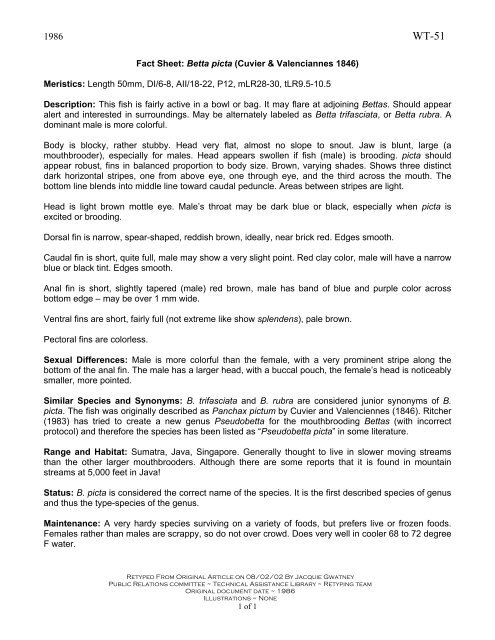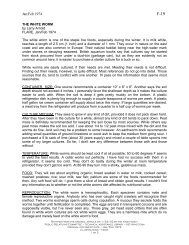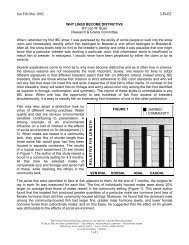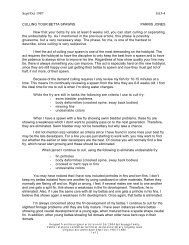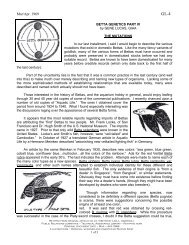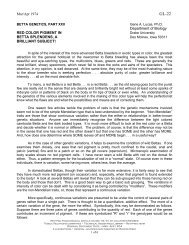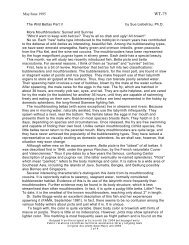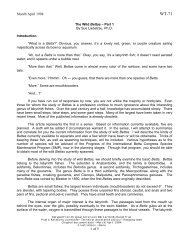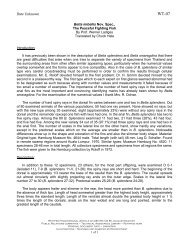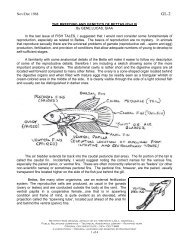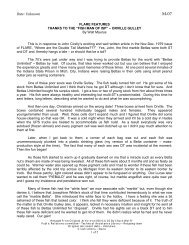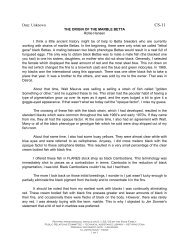WT-51: Betta picta (Cuvier & Valenciannes 1846)
WT-51: Betta picta (Cuvier & Valenciannes 1846)
WT-51: Betta picta (Cuvier & Valenciannes 1846)
You also want an ePaper? Increase the reach of your titles
YUMPU automatically turns print PDFs into web optimized ePapers that Google loves.
1986 <strong>WT</strong>-<strong>51</strong><br />
Fact Sheet: <strong>Betta</strong> <strong>picta</strong> (<strong>Cuvier</strong> & <strong>Valenciannes</strong> <strong>1846</strong>)<br />
Meristics: Length 50mm, DI/6-8, AII/18-22, P12, mLR28-30, tLR9.5-10.5<br />
Description: This fish is fairly active in a bowl or bag. It may flare at adjoining <strong>Betta</strong>s. Should appear<br />
alert and interested in surroundings. May be alternately labeled as <strong>Betta</strong> trifasciata, or <strong>Betta</strong> rubra. A<br />
dominant male is more colorful.<br />
Body is blocky, rather stubby. Head very flat, almost no slope to snout. Jaw is blunt, large (a<br />
mouthbrooder), especially for males. Head appears swollen if fish (male) is brooding. <strong>picta</strong> should<br />
appear robust, fins in balanced proportion to body size. Brown, varying shades. Shows three distinct<br />
dark horizontal stripes, one from above eye, one through eye, and the third across the mouth. The<br />
bottom line blends into middle line toward caudal peduncle. Areas between stripes are light.<br />
Head is light brown mottle eye. Male’s throat may be dark blue or black, especially when <strong>picta</strong> is<br />
excited or brooding.<br />
Dorsal fin is narrow, spear-shaped, reddish brown, ideally, near brick red. Edges smooth.<br />
Caudal fin is short, quite full, male may show a very slight point. Red clay color, male will have a narrow<br />
blue or black tint. Edges smooth.<br />
Anal fin is short, slightly tapered (male) red brown, male has band of blue and purple color across<br />
bottom edge – may be over 1 mm wide.<br />
Ventral fins are short, fairly full (not extreme like show splendens), pale brown.<br />
Pectoral fins are colorless.<br />
Sexual Differences: Male is more colorful than the female, with a very prominent stripe along the<br />
bottom of the anal fin. The male has a larger head, with a buccal pouch, the female’s head is noticeably<br />
smaller, more pointed.<br />
Similar Species and Synonyms: B. trifasciata and B. rubra are considered junior synonyms of B.<br />
<strong>picta</strong>. The fish was originally described as Panchax pictum by <strong>Cuvier</strong> and Valenciennes (<strong>1846</strong>). Ritcher<br />
(1983) has tried to create a new genus Pseudobetta for the mouthbrooding <strong>Betta</strong>s (with incorrect<br />
protocol) and therefore the species has been listed as “Pseudobetta <strong>picta</strong>” in some literature.<br />
Range and Habitat: Sumatra, Java, Singapore. Generally thought to live in slower moving streams<br />
than the other larger mouthbrooders. Although there are some reports that it is found in mountain<br />
streams at 5,000 feet in Java!<br />
Status: B. <strong>picta</strong> is considered the correct name of the species. It is the first described species of genus<br />
and thus the type-species of the genus.<br />
Maintenance: A very hardy species surviving on a variety of foods, but prefers live or frozen foods.<br />
Females rather than males are scrappy, so do not over crowd. Does very well in cooler 68 to 72 degree<br />
F water.<br />
Retyped From Original Article on 08/02/02 By Jacquie Gwatney<br />
Public Relations committee ~ Technical Assistance Library ~ Retyping team<br />
Original document date ~ 1986<br />
Illustrations ~ None<br />
1 of 1
1986 <strong>WT</strong>-<strong>51</strong><br />
Breeding and Raising: Perhaps the easiest mouthbrooding <strong>Betta</strong> to breed and raise. Temperature is<br />
not critical. They will spawn between 72 to 80 degrees F.<br />
They may be isolated in pairs to spawn, however, they will spawn “naturally” in a community set up.<br />
The pair spawn near the bottom. The female is the more aggressive of the two, chasing away rival B.<br />
<strong>picta</strong> females and other fish from the spawning site while the male waits. The pair embrace in typical<br />
anabantoid or <strong>Betta</strong> fashion at the bottom. The female recovers from the embrace first and picks up the<br />
eggs off the anal fin of the male and the bottom. The male recovers. The female spits the eggs out in<br />
front of the male’s mouth, one or sometimes two at a time. They both attempt to snap up the eggs out<br />
of the mid water. Eventually all the eggs are collected by the male and the pair embraces again. This<br />
continues until presumably all the eggs are expelled by the female.<br />
The male holds on to the eggs for 11 to 14 days before spitting the fry out. The fry usually hatch at<br />
about 3 days in the male’s mouth. At first they are mostly egg sac. By the time the male spits them out<br />
they have absorbed the egg sac and are relatively large for anabantoid fry. They will eat baby brine<br />
shrimp easily at this state.<br />
Sometimes the father will hold on to the fry too long and the fry will die. To prevent this the aquarist can<br />
choke the male, that is, force his mouth open. The fry of B. <strong>picta</strong> are relatively hardy and will survive<br />
choking even if the egg sac is not entirely absorbed.<br />
Availability (1986): Although not commercially farmed, this is the most readily available mouthbrooding<br />
<strong>Betta</strong> species to the hobbyist. This is mainly because it is easy to breed. Sometimes imported<br />
specimens are available.<br />
References:<br />
Fazio R. A. (1985). Why not try some “Tris”, <strong>Betta</strong> trifasciata, Flare 18:4, 24.<br />
Goldstein (1971). Anabantoids Gouramis and Related Fishes TFH Publications, Jersey City, N. J.<br />
Liebetrau, S. (1982). The wild <strong>Betta</strong>s, part 4, Mixed Up Mouth Brooders. FAMA 5:4, 29.<br />
Liebetrau, S. (1983). The wild <strong>Betta</strong>s, part 5, More Mouthbrooders: Sunset and Sunrise. FAMA 5:54,<br />
38.<br />
Pinter, H. (1984). Labyrinth Fish. Barron’s Educational Series, Inc., Woodbury N.Y.<br />
Regan, T. (1909). The Asiatic Fishes of the Family Anabantidae, Proc. Zool. Soc. Lond. 77, 779.<br />
Richter, J. H. (1982). Das Buch der Labyrinthfische. Translated by M. Cain.<br />
Saunders, S. (1986). Confessions of a <strong>Betta</strong> mid-wife. Flare 19:5, 10.<br />
Saunders, S. (1983). Breeding <strong>Betta</strong> <strong>picta</strong>. Flare 17:1, 29.<br />
Vierke, J. (1978). Labyrinthefische und verwandt arten (German). Wupertal, Pfriem-Verlag. Translated<br />
by S. & A. Liebetrau, B. Mannion and A. Sigwald. (1981)<br />
Vierke, J. (1986). The bubblenest building <strong>Betta</strong>s, an alternative viewpoint. FAMA 9:7, 44.<br />
Retyped From Original Article on 08/02/02 By Jacquie Gwatney<br />
Public Relations committee ~ Technical Assistance Library ~ Retyping team<br />
Original document date ~ 1986<br />
Illustrations ~ None<br />
2 of 2


